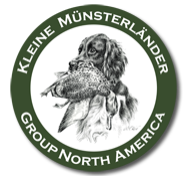“So which stud dog should I choose?”
This question has occupied generations of breeders. Chance, luck and risk play a major role in this matter.
Our breeders are the backbone of each KlM club. They always make a great effort to choose a good match of parents for KlM offspring. The breeder should thoroughly know the bitch and be able to evaluate her qualities, strengths and risks. It is difficult, however, with the stud dog.
It is ideal, if a breeder has already gotten to know the stud dog in hunting situations and could determine how he looked, moved and hunted together with his handler. Perhaps the breeder has already learned, whether the stud dog has bred and what qualities it has passed on. This information is rare, however, because interesting stud dogs are not always located in an area nearby, or there are no opportunities to hunt together. But even if the breeder already knows the stud dog somewhat, they usually do not know, which strengths and weaknesses are present in his line of ancestors—whether there were diseases which could be passed on, or how the family relationships of his potential stud dog and bitch have been in past generations, or whether unwanted inbreeding problems could arise. Also, most of the puppies from past litters of the stud dog, and what has become of them, is often unknown.
For this reason, many breeders say, “I’ll have a look at the test results, because if I can get a well-performing stud dog, then I’ll have a good litter” or “The best ones are just right for my bitch!”, or “If a lot of other breeders go to a certain stud dog, then he can’t be bad”. But: that such stud dogs could be good for a specific pairing, might be true, but doesn’t have to be true.
About 30 years ago, those responsible for breeding at KlM-Germany (KlM-D) sought scientific advice from geneticists and established a database together with the Publishing House for Animal Breeding and Applied Genetics (TG Verlag). This database now contains information on more than 50,000 KlM which results in a large reservoir of experience available to guide systematic breeding.
This database is named “Dogbase”, and the software is called “Breeding Evaluation”. The data and the system make an analysis of the pedigree of a dog across four generations possible. It enables the planning of a pairing with two specific parent animals by considering their line of ancestors and calculates what breeding values could be theoretically expected for the puppies of this match. In other words, the parents have individual breeding values, and the system calculates the expected breeding values for the puppies.
The system shows expected breeding values for abilities like “Laut”, “tracking”, “work on a live duck”, “field search”, “pointing”, “cooperation”, “gun sensitivity”, “hip quality”, “risk of hernia”” and “size”. Furthermore, the “inbreeding coefficient” as well as the “homogeneity coefficient” of the pairing are calculated, in each case, with an evaluation of five generations, and finally also the “risk for epilepsy”.
With these expected values, the breeding evaluation makes interesting information available to breeders in Germany. They should take into account, however, that we are dealing with theoretical values, which represent probabilities, but cannot, of course, offer certainty about the quality of the puppies. But they offer breeders numerous reference values and show connections. Especially with the planned reduction of the risks of hereditary diseases, the breeding evaluation values are very helpful. With this, hip dysplasia in the German KlM population, for example, could be curtailed to such an extent, that it no longer has any practical significance for the German KlM.
The Breed Wardens of the various Landesgruppen (German regional clubs) in KlM-Germany are regularly schooled in the use of the breed value estimates and the analysis of their scores. They are thereby in a position to carefully advise their breeders in the planning of future pairings. German KlM breeders get assistance from professionals, when they are confronted with the question: “Which stud dog should I choose?” The final decision still remains with the breeder; their experience, knowledge and instincts are crucial in making a decision.
(Used by permission of the author, Bernd-Dieter Jesinghausen, former President of the Verband für Kleine Münsterländer Vorstehhunde e.V. and the founder of KlM International.)

